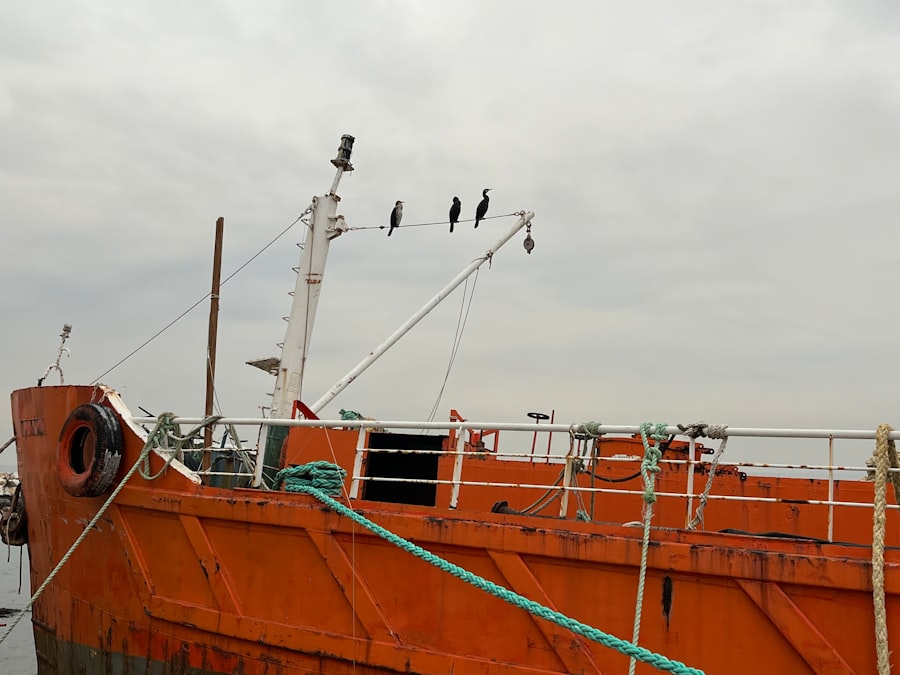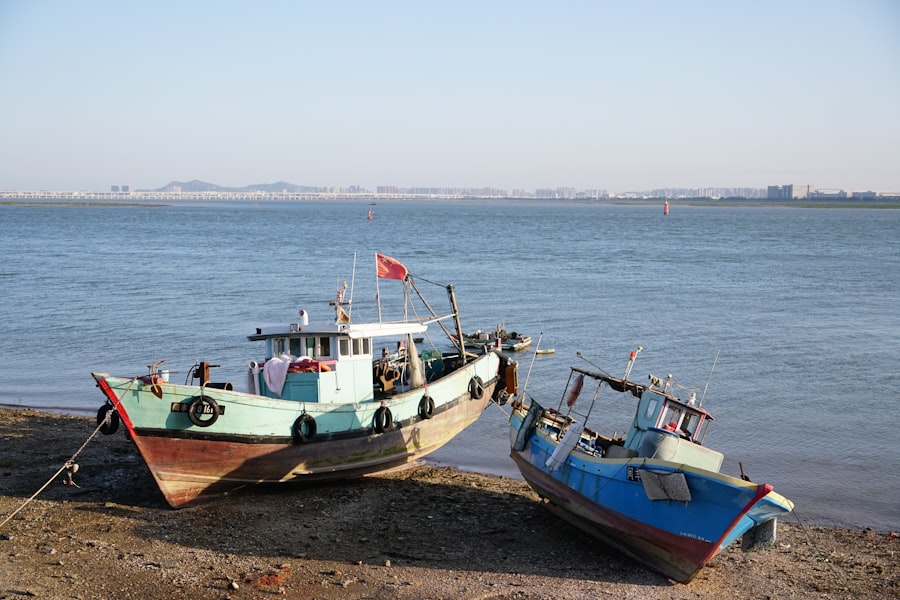Trawlers are a unique category of boats designed primarily for long-distance cruising and fishing. They are characterized by their displacement hulls, which allow for efficient travel at lower speeds, making them ideal for extended voyages. Unlike speedboats or yachts that prioritize speed and agility, trawlers emphasize stability, comfort, and fuel efficiency.
This makes them particularly appealing to those who enjoy leisurely exploration of coastal waters or offshore adventures. The design of a trawler typically includes a full keel, which enhances stability and allows for better handling in rough seas. The interior of a trawler is often designed with comfort in mind, featuring spacious living quarters, a galley, and sometimes even multiple cabins.
This makes them suitable for families or groups looking to spend extended periods on the water. Many trawlers also come equipped with amenities such as heating systems, air conditioning, and advanced navigation equipment, ensuring that the experience is as comfortable as possible. Understanding the fundamental characteristics of trawlers is essential for potential buyers, as it helps set realistic expectations regarding performance, maintenance, and overall usage.
Key Takeaways
- Trawlers are versatile boats designed for long-distance cruising with fuel efficiency and comfort.
- Key factors in choosing a trawler include size, range, layout, and intended use.
- Various types of trawlers are available, such as coastal, offshore, and expedition models.
- Inspecting a trawler thoroughly before purchase is crucial to ensure seaworthiness and value.
- Proper maintenance and understanding financing options are essential for a successful trawler ownership experience.
Factors to Consider When Choosing a Trawler
When selecting a trawler, several critical factors must be taken into account to ensure that the vessel meets your specific needs and preferences. One of the foremost considerations is the size of the trawler. Trawlers can range from small models around 30 feet to larger vessels exceeding 50 feet.
The size will significantly influence not only the comfort level onboard but also the vessel’s handling capabilities and fuel efficiency. A larger trawler may offer more living space and amenities but could also be more challenging to maneuver in tight spaces or shallow waters. Another important factor is the intended use of the trawler.
Will it primarily serve as a fishing boat, a liveaboard for extended cruising, or a weekend getaway vessel? Each purpose may dictate different features and specifications. For instance, if fishing is a priority, you might want to look for models equipped with fishing gear storage, rod holders, and perhaps even a built-in fish finder.
Conversely, if you plan to live aboard, you may prioritize comfort features such as a well-equipped kitchen and ample sleeping arrangements. Understanding your primary use case will help narrow down your options significantly.
Types of Trawlers Available for Sale

The market offers a diverse array of trawlers, each designed with specific features that cater to different preferences and needs. One popular type is the displacement trawler, which is designed for long-distance cruising at lower speeds. These vessels are built for stability and fuel efficiency, making them ideal for those who enjoy leisurely voyages rather than high-speed travel.
Displacement trawlers often feature robust hull designs that can handle rough seas while providing a comfortable ride. Another category is the semi-displacement trawler, which combines elements of both displacement and planing hulls. These vessels can achieve higher speeds than traditional displacement trawlers while still maintaining some of their stability and fuel efficiency characteristics.
This makes them versatile options for those who want the best of both worlds—capable of cruising at a leisurely pace but also able to pick up speed when necessary. Additionally, there are also expedition trawlers designed for serious adventurers who plan to explore remote areas or undertake long voyages in various sea conditions. These boats often come equipped with advanced navigation systems and rugged construction to withstand challenging environments.
Where to Find Trawlers for Sale
| Source | Type of Trawlers Available | Price Range | Location | Additional Notes |
|---|---|---|---|---|
| Boat Trader | New and Used Trawlers | 30,000 – 1,000,000+ | USA, Canada | Wide selection, detailed listings with photos |
| YachtWorld | Luxury and Classic Trawlers | 50,000 – 5,000,000+ | Global | Includes broker services and financing options |
| Craigslist | Used Trawlers | 10,000 – 200,000 | Local regions | Varies greatly, buyer beware |
| Local Marinas | Used Trawlers | Varies | Local | Opportunity to inspect in person |
| Boat Shows | New and Used Trawlers | Varies | Regional and National | Chance to meet sellers and brokers directly |
| Online Forums and Groups | Used Trawlers | Varies | Global | Community advice and private sales |
Finding the right trawler for sale can be an exciting yet daunting task. Various platforms cater to different buyer preferences, ranging from online marketplaces to specialized boat dealerships. Websites like YachtWorld and Boat Trader offer extensive listings of new and used trawlers across various price ranges and specifications.
These platforms allow potential buyers to filter their searches based on criteria such as size, price, year built, and location, making it easier to find a suitable vessel. In addition to online resources, attending boat shows can provide invaluable opportunities to see multiple trawlers in person. Events like the Fort Lauderdale International Boat Show or the Miami International Boat Show feature numerous exhibitors showcasing their latest models.
This allows prospective buyers not only to inspect the vessels up close but also to engage with manufacturers and dealers directly, gaining insights into the latest trends and technologies in the trawler market. Networking with other boaters at these events can also lead to recommendations for reputable sellers or even private sales.
Tips for Inspecting a Trawler Before Purchase
Before finalizing any purchase, conducting a thorough inspection of the trawler is crucial to ensure that it meets your expectations and is in good condition. Start by examining the hull for any signs of damage or wear. Look for blisters, cracks, or signs of osmosis that could indicate underlying issues.
A well-maintained hull should be free from significant blemishes and should have been regularly cleaned and painted. Next, pay close attention to the engine and mechanical systems. Request maintenance records to verify that routine services have been performed consistently.
If possible, arrange for a marine surveyor to conduct a professional inspection; they can provide an unbiased assessment of the vessel’s condition and identify any potential problems that may not be immediately visible to an untrained eye. Additionally, test all onboard systems such as electrical components, plumbing, and navigation equipment to ensure they are functioning correctly.
Financing Options for Buying a Trawler

Financing a trawler can be a complex process due to the varying costs associated with different models and types of vessels. Many buyers opt for marine loans specifically designed for purchasing boats. These loans typically offer competitive interest rates and flexible terms tailored to the unique nature of boat ownership.
When considering financing options, it’s essential to shop around and compare offers from various lenders to find the best deal. Another option is to explore personal loans or home equity lines of credit if you have sufficient equity in your home. While these options may provide lower interest rates than traditional marine loans, they often come with different terms and conditions that could affect your financial situation in the long run.
It’s advisable to consult with a financial advisor who specializes in marine financing to understand all available options thoroughly before making a decision.
Maintenance and Upkeep of Trawlers
Owning a trawler comes with its share of responsibilities regarding maintenance and upkeep. Regular maintenance is essential not only for ensuring safety but also for preserving the vessel’s value over time. One critical aspect is engine maintenance; this includes routine oil changes, checking fuel filters, and inspecting belts and hoses for wear.
Keeping up with these tasks can prevent costly repairs down the line and ensure that your engine runs smoothly during your voyages. In addition to mechanical upkeep, attention must also be given to the hull and exterior surfaces. Regular cleaning helps prevent barnacle growth and other marine fouling that can affect performance.
Applying anti-fouling paint every few years can protect the hull from deterioration caused by saltwater exposure. Furthermore, inspecting seals around windows and hatches is vital in preventing leaks that could lead to mold or structural damage over time.
Sailing Adventures with Your Trawler
Once you’ve acquired your trawler and ensured it’s in top condition, the real adventure begins—sailing! Trawlers are perfect for exploring coastal regions, visiting remote islands, or even embarking on longer journeys across oceans. Their design allows for comfortable living while at sea, making them ideal for extended trips where you can immerse yourself in nature and enjoy breathtaking views.
Planning your sailing adventures involves considering various factors such as weather conditions, navigational routes, and potential ports of call along your journey. Many trawler owners enjoy creating itineraries that include stops at charming coastal towns or secluded anchorages where they can enjoy swimming, fishing, or simply relaxing on deck with a good book. The versatility of trawlers allows you to adapt your plans based on changing conditions or personal preferences, making each voyage unique and memorable.
In conclusion, owning a trawler opens up a world of possibilities for exploration and adventure on the water. With careful consideration during the purchasing process and diligent maintenance practices afterward, you can enjoy countless memorable experiences aboard your vessel while forging lasting connections with fellow boating enthusiasts along the way.


